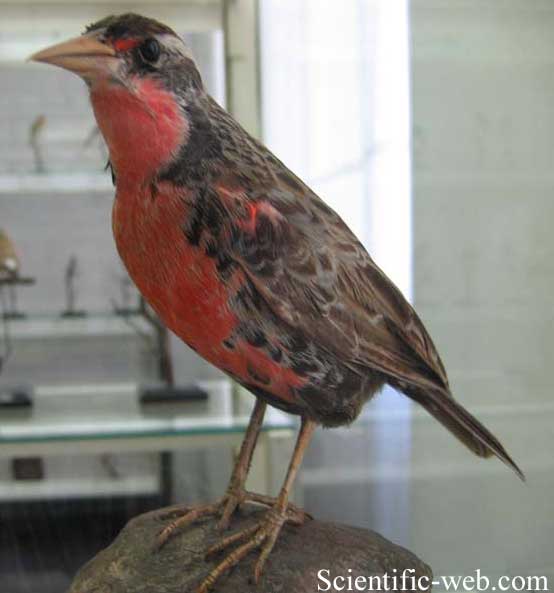
Leistes militaris, Photo: Michael Lahanas
Superregnum: Eukaryota
Cladus: Unikonta
Cladus: Opisthokonta
Cladus: Holozoa
Regnum: Animalia
Subregnum: Eumetazoa
Cladus: Bilateria
Cladus: Nephrozoa
Superphylum: Deuterostomia
Phylum: Chordata
Subphylum: Vertebrata
Infraphylum: Gnathostomata
Megaclassis: Osteichthyes
Cladus: Sarcopterygii
Cladus: Rhipidistia
Cladus: Tetrapodomorpha
Cladus: Eotetrapodiformes
Cladus: Elpistostegalia
Superclassis: Tetrapoda
Cladus: Reptiliomorpha
Cladus: Amniota
Classis: Reptilia
Cladus: Eureptilia
Cladus: Romeriida
Subclassis: Diapsida
Cladus: Sauria
Infraclassis: Archosauromorpha
Cladus: Crurotarsi
Divisio: Archosauria
Cladus: Avemetatarsalia
Cladus: Ornithodira
Subtaxon: Dinosauromorpha
Cladus: Dinosauriformes
Cladus: Dracohors
Cladus: Dinosauria
Ordo: Saurischia
Cladus: Eusaurischia
Subordo: Theropoda
Cladus: Neotheropoda
Cladus: Averostra
Cladus: Tetanurae
Cladus: Avetheropoda
Cladus: Coelurosauria
Cladus: Tyrannoraptora
Cladus: Maniraptoromorpha
Cladus: Maniraptoriformes
Cladus: Maniraptora
Cladus: Pennaraptora
Cladus: Paraves
Cladus: Eumaniraptora
Cladus: Avialae
Infraclassis: Aves
Cladus: Euavialae
Cladus: Avebrevicauda
Cladus: Pygostylia
Cladus: Ornithothoraces
Cladus: Ornithuromorpha
Cladus: Carinatae
Parvclassis: Neornithes
Cohors: Neognathae
Cladus: Neoaves
Cladus: Telluraves
Cladus: Australaves
Ordo: Passeriformes
Subordo: Passeri
Infraordo: Passerida
Superfamilia: Passeroidea
Familia: Icteridae
Genus: Leistes
Species Leistes militaris
Name
Leistes militaris (Linnaeus, 1758)
Synonyms
Emberiza militaris (protonym)
Pezites militaris (Linnaeus, 1758)
Sturnella militaris (Linnaeus, 1758)
see discussion re Leistes defilippii sometimes called S. militaris.
References
Primary references
Linnaeus, C. 1758. Systema Naturae per regna tria naturae, secundum classes, ordines, genera, species, cum characteribus, differentiis, synonymis, locis. Editio Decima, Reformata. Tomus I. Holmiæ (Stockholm): impensis direct. Laurentii Salvii. 824 pp. DOI: 10.5962/bhl.title.542 BHL p. 178 BHL Reference page.
Additional references
Powell, A. F.L.A., Barker, F. K., Lanyon, S. M., Burns, K. J., Klicka, J., & Lovette, I. J. 2014. A comprehensive species-level molecular phylogeny of the New World blackbirds (Icteridae). Molecular Phylogenetics and Evolution 71: 94-112. DOI: 10.1016/j.ympev.2013.11.009 Full article (PDF)Reference page.
Vernacular names
English: Red-breasted Blackbird
Esperanto: Ruĝbrusta sturnelo
español: Loica pechirroja
français: Sturnelle militaire
Nederlands: Soldatenspreeuw
português: Polícia-inglesa-do-norte
svenska: Soldattrupial
The red-breasted meadowlark (Leistes militaris) is a passerine bird in the New World family Icteridae. It was formerly named red-breasted blackbird but is not closely related to the red-winged blackbird group.[2]
The red-breasted meadowlark is resident from south-western Costa Rica, which it has recently colonised, and Trinidad, south to north-eastern Peru and central Brazil. In 2008, it was sighted for the first time in Nicaragua.[3]
Like other meadowlarks, it is a bird associated with open country, including moist grasslands, pasture and cultivation, preferably with the odd bush or fence post for males to use as a songpost. In display the male flies up to 10 m (33 ft) in the air, then parachutes down on folded wings whilst singing a wheezing song, ti-ti-pee-pee-KWAAAAAA. The call is a short tsip.
The red-breasted meadowlark builds a deep grass-lined open cup nest on the ground amongst tall grasses, with several nests often close together. The normal clutch is two to four reddish brown-blotched cream eggs.
The red-breasted meadowlark is a small icterid, 19 cm (7.5 in) long and weighing 40–48 g (1.4–1.7 oz). Males are larger than females. The male has mainly black plumage, apart from a bright red throat, belly and wing epaulets. This striking "redcoat" plumage gives rise to the specific name militaris and the Trinidadian name "soldier bird".
The female has buff edged dark brown upperpart feathers, buff underparts with a reddish tinge, and pale streaks through the crown and eye. Juveniles resemble the female, but are paler and lack the reddish tint to the underparts.
This species is very closely related to the white-browed meadowlark, S. superciliaris which breeds further south, and was formerly considered to be subspecies of red-breasted meadowlark. The male white-browed is easily distinguished by his bright white supercilium, but females of the two species are almost identical. Female red-breasted meadowlarks are longer billed, smaller, and shorter winged than their relative, with more red and less streaking on the underparts.
This gregarious bird feeds mainly on insects and some seeds, including rice, and forages on the ground like a bobolink.
The red-breasted meadowlark has benefited from the more open habitat created by forest clearance and ranching, and is extending its range. It is uncertain whether sightings on Tobago represent a small breeding population or wanderers from Trinidad or South America.
References
BirdLife International (2020). "Leistes militaris". IUCN Red List of Threatened Species. 2020: e.T22729346A138328502. doi:10.2305/IUCN.UK.2020-3.RLTS.T22729346A138328502.en. Retrieved 12 November 2021.
"A classification of the bird species of South America: Recent Changes".
Arendt, Wayne J.; Tórrez, Marvin A (Autumn 2009). "First documented record of Red-breasted Blackbird Sturnella militaris in Nicaragua". Cotinga. 31: 119–120.
New World Blackbirds by Jaramillo and Burke, ISBN 0-7136-4333-1
ffrench, Richard (1991). A Guide to the Birds of Trinidad and Tobago (2nd ed.). Comstock Publishing. ISBN 0-8014-9792-2.
Hilty, Steven L (2003). Birds of Venezuela. London: Christopher Helm. ISBN 0-7136-6418-5.
Retrieved from "http://en.wikipedia.org/"
All text is available under the terms of the GNU Free Documentation License

